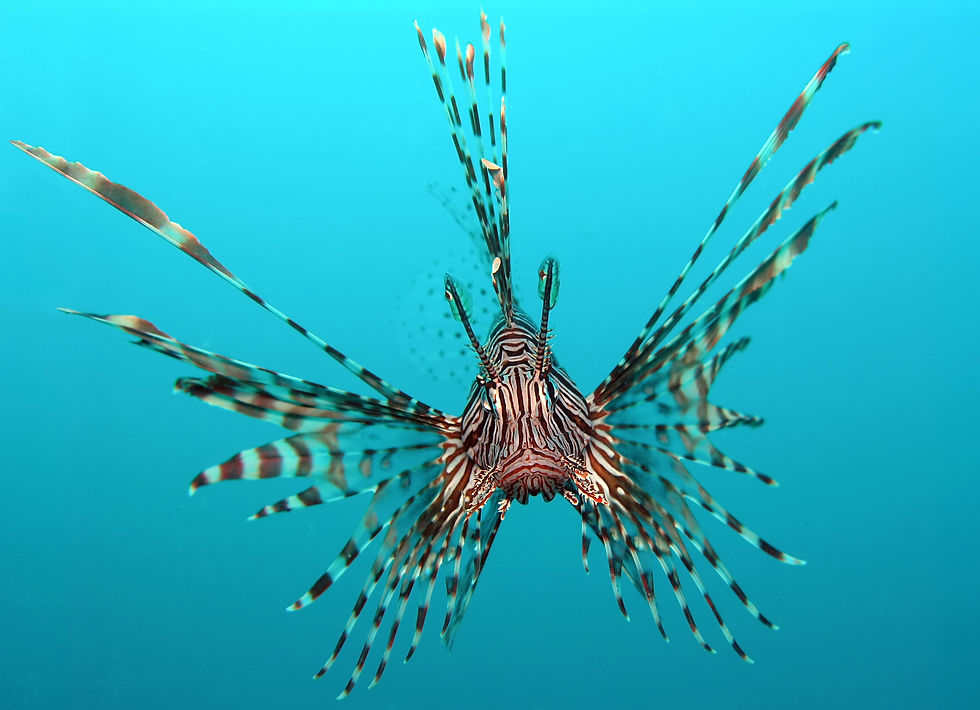SIEGE OF THE SEA DEVILS
- BunjyWunjy
- Jul 31, 2018
- 4 min read
Hey everyone, happy friday and welcome back to another excellent episode of Weird Biology! This week, we’re examining a charismatic and almost perfect oceanic killing machine! You might be picturing a shark, but you’re wrong. It’s the flamboyant, fantastic, and absolute ecological nightmare, the


NAAAAAANTS INGONYAAAAMAA
Lionfish are a group of 12 species in the genus Pterois (tare-oh-eese), meaning “winged”. These fish are among the most striking and beautiful in the ocean! They’re also full of poison knives, but more on that later. Also called Dragonfish, Firefish, Turkeyfish, Tastyfish or PEZ DIABLO (Devilfish, or “underwater satan” if you use Google Translate), Lionfish are native to the Southern Pacific and Indian oceans. They are mostly found on coral reefs, where they can grow up to 17 inches long and reach about 3 pounds.

3 pounds of UNDERWATER KNUCKLE SANDWICH.
See, when it comes to sheer ridiculous ability to survive anywhere, Lionfish are dang near perfect. Most reef fish are specialized creatures with a fairly low set of tolerances but not Lionfish! for starters, they’re common in every level of the water column up to 1000 feet down. That’s impressive for a regular fish, let alone a reef specialist. They can also tolerate temperatures as low as 60 F, which again, completely ridiculous. This fish could probably survive on the moon.
On top of that, their reproductive rate is insane. unlike many reef fish who follow a yearly cycle, Lionfish reproduce monthly. And every month a female Lionfish may lay- wait for it- 15,000 eggs. Add in the fact that they have maybe three natural predators and it’s a wonder we aren’t knee deep in them right now. (Good news! the Lionfish will submerge us before the oceans do!)
Lionfish may look like delicate lacy parasols, but that bold striped coloration is actually Nature’s equivalent of wearing a bright orange hazard vest while standing on the roof of a burned-out van, waving a submachine gun at traffic. See, those lacy fins are are concealing dozens and dozens of long, razor-sharp spines venomous enough to incapacitate a human. Any predator unwary enough to get a mouthful of the Lionfish’s poison shiv collection will experience immediate debilitating pain, paralysis, and almost certain death. (This venom isn’t strong enough to kill a healthy adult, but it really sucks and can floor you for at least a day. Do not touch.)

It’s time to play our favorite biology game, How Many Poison Knives Is This Animal Packing? If you guess wrong, you die.
Lionfish are voracious eating machines, in addition to being basically a floating wedding dress full of poison ice picks. They feed on fish, invertebrates, mollusks, and even smaller Lionfish. These flamboyant cannibals feed by disorienting their prey with a jet of water, and then swallowing it headfirst like a Hardees breakfast sandwich. And they’ll cram as many fish/shrimp/members of their own species into that ravenous maw as possible- a Lionfish’s stomach can expand to 30 times its original size on a binge! And in lean times, the Lionfish can slow its metabolism to a literal crawl. They can survive a three-month fast and lose only 10% of their body weight. Yeesh. Can anything stop these frilly nightmares?
(SPOILER ALERT: no.)
The question is unfortunately relevant. At some point, Lionfish were released off the Atlantic coast of North America either from hurricanes or the pet trade. (Probably both.) In the last 10 or so years, those few Free-Willied individuals have become MILLIONS. Lionfish have launched a hostile invasion of Carribean waters, and are now found from the Gulf Coast to North Carolina. this is a big dang problem.
Apart from how dangerous they are, the Lionfish’s natural fish superiority allows it to easily outcompete the meek and innocent native fish. This is putting stress on invaded reef ecosystems, and the problem is only getting worse as Lionfish continue to spread further north. Lionfish are even learning to tolerate mildly brackish water and have been found in estuaries four miles from the ocean. At this rate, we’re all going to wake up and find a Lionfish in our beds. (It’s their bed now. Accept your inferiority before Earth’s true dominant species.) The fate of these oceans rests on the questionable shoulders of the Lionfish’s only (un)natural predator:
you.
The only current way to slow their spread is to just eat the absolute heck out of them. That’s right, Lionfish are edible! And not just that, they’re completely delicious and heart-healthy, part of this complete breakfast! They’re called Tastyfish for a reason. And for all their prowess, Lionfish have yet to evolve a defense for projectile weapons. (That’s what happens when you put all your skill points into Melee, Lionfish.) And remember: eating a Lionfish is taking part in the front lines of a battle for the future of your oceans. Also, they’re just delicious. So do your part, and eat up!

EAT EM UP YUM!
IMAGE SOURCES
1. Jens Peterson, Wikimedia Commons
2. Alexander Vasenin, Wikimedia Commons
3. Christian Mehlführer, Wikimedia Commons
4. Bekah Nelson, Flickr

Comments